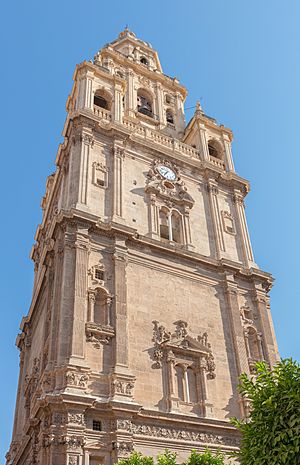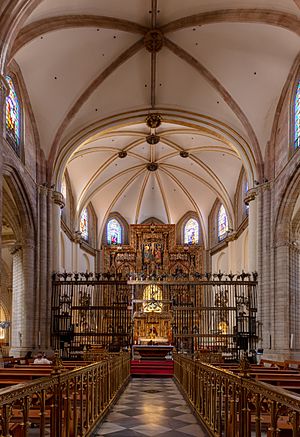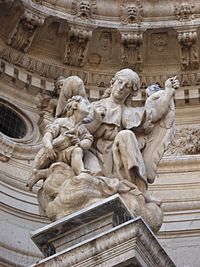Murcia Cathedral facts for kids
Quick facts for kids Cathedral Church of Saint Mary |
|
|---|---|
|
Santa Iglesia Catedral de Santa María
|
|

Cathedral Church of Saint Mary of the Diocese of Cartagena in Murcia
|
|
| Religion | |
| Affiliation | Roman Catholic Church |
| Province | Diocese of Cartagena |
| Ecclesiastical or organizational status | Cathedral |
| Location | |
| Location | Murcia, Spain |
| Architecture | |
| Architectural type | Church |
| Architectural style | Gothic, Renaissance, Baroque |
| Groundbreaking | 1394 |
| Completed | 1465 |
The Cathedral of Murcia is a beautiful and historic Catholic church in the city of Murcia, Spain. It's also known as the Cathedral Church of Saint Mary. This important building serves as the main church for the Roman Catholic Diocese of Cartagena.
Contents
History of the Cathedral
Building a Grand Church
The story of the Cathedral of Murcia began a long time ago. In the 13th century, a Christian king named Jaime I the Conqueror took control of the city of Murcia. He turned the city's main mosque into a church dedicated to the Virgin Mary. This was a common practice for him after conquering a new place.
However, the actual construction of the cathedral didn't start until the 14th century. Workers began laying the foundations in 1385. The very first stone was placed in 1388. It took another six years for the building to really start rising. The main construction was finished in October 1467. But the cathedral continued to change and grow until the 18th century, showing off many different art styles.
Architectural Styles and Royal Connections
Inside, the cathedral mostly has a Gothic style. This means it has tall arches and large stained-glass windows. The front of the cathedral, called the facade, is in the Baroque style. It was designed by a talented architect from Valencia named Jaume Bort i Meliá.
A special part of the cathedral is under the main altar. The heart and other organs of King Alfonso X the Wise are buried there. He asked for this in his will. It was a gift and a sign of his love for Murcia, and a thank you for the city's loyalty to him.
Fire and Restoration
In 1854, a terrible fire damaged the cathedral. It destroyed the main altar and the choir stalls. To fix this, a new altar was created in a Neo-Gothic style. This was done by sculptors Pescador and Palao. A grand organ was also ordered from a Belgian company called Merklin-Schütze. Under the organ, beautiful 16th-century chairs were placed. These chairs came from the Monastery of Santa Maria de Valdeiglesias. Queen Isabel II donated them to the cathedral.
The Bell Tower
The cathedral's bell tower is very impressive. It was built over a long period, from 1521 to 1791. It stands about 90 meters (295 feet) tall. With its weathervane, it reaches about 95 meters (312 feet). This makes it the tallest bell tower in Spain!
The tower has five different levels, each with a different width. It also combines several architectural styles:
- The first level was built by Francisco and Jacobo Florentino. It has a square shape and a Renaissance style. It also shows influences from the Spanish Plateresque style, which is known for its detailed decorations.
- The second level was made by Jerónimo Quijano. It has a similar style but is a bit simpler and purer.
- The third floor is in the Baroque style. It has a Rococo-style body and a dome designed by Ventura Rodríguez in a Neoclassic style.
- On the fourth floor, there are four special rooms called conjuratories. These rooms are in each corner. Priests used to hold special ceremonies here to protect the city from storms. They would use a piece of the Lignum Crucis (a relic believed to be part of the cross of Jesus) during these ceremonies.
The Cathedral Bells
There are twenty-five bells in the cathedral. All of them were made in the 17th and 18th centuries. Each bell has its own unique name. Some of them include:
- The Bell of the Spells
- La Catalana
- The Bell of Prayer
- La Fuensanta
- The Conception
- La Segundilla
- The greater bell, or Agueda-Martillo, which is the main bell.
The bells have played an important role in the city's history. They have been used to warn people about big floods from the Segura River. They also announced wars, celebrations, and other festivities. The oldest bell, called la Campana Mora (the moor bell), dates back to the 14th century. It is now kept in the Museum of the Cathedral of Murcia.
Inside the Cathedral
The inside of the Cathedral of Murcia is mostly in the Gothic style. It has three main sections called naves. It also has an apse (a rounded end part) and twenty-three chapels. These chapels are dedicated to the patron saints of different worker groups. They also serve as burial places for bishops and nobles who helped build the cathedral.
Some of the notable chapels include:
- The Chapel of the Apse or the Vélez Chapel: This chapel has a unique "Flaming Gothic" style. It features a special dome shaped like a ten-pointed star.
- The Chapel of Junterones: This is considered one of the most important works of the Spanish Renaissance.
- The Chapel of the Immaculate: This chapel is designed in the Baroque style.
Other important features inside are the detailed Plateresque chairs in the choir area. The post-choir and the entrance to the sacristy (a room where priests prepare for services) are also very impressive.
Outside the Cathedral
The exterior of the Cathedral of Murcia has many interesting parts:
- Door of the Apostles: This door was built in 1488 by Diego Sánchez de Almazán. It is in the Gothic style. On the sides of the door, you can see sculptures of the four apostles. There is also a shield honoring Queen Isabel the Catholic.
- Chapel of the Marquess of Vélez: This chapel has a polygonal (many-sided) shape. It is decorated with the shields of the Chacones and Fajardos families.
- Door of the Chains: This door has two main parts. The lower part is from the 16th century, and the upper part is from the 18th century. It features carvings of the brothers San Leandro, San Isidoro, and San Fulgencio.
- Main Facade: The main front of the cathedral is in the Baroque style. It is known for its exceptional beauty and unique design. It was built thanks to the efforts of the Cabildo (the cathedral's governing body) and with help from Cardinal Belluga. It was designed by Jaime Bort.
- Exaltation of the Virgin Mary: This is a theme often seen in the cathedral's art, celebrating the Virgin Mary.
See also
 In Spanish: Catedral de Murcia para niños
In Spanish: Catedral de Murcia para niños
- History of early modern period domes




